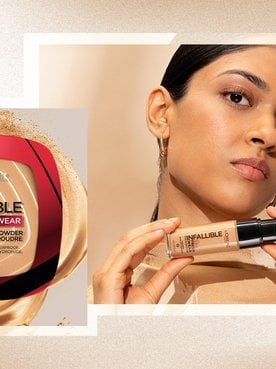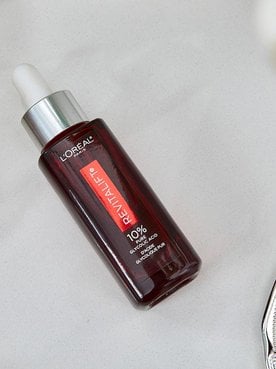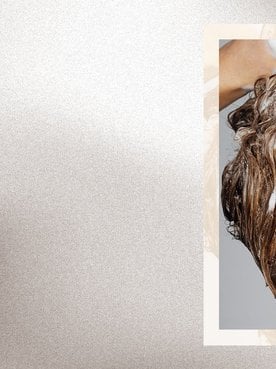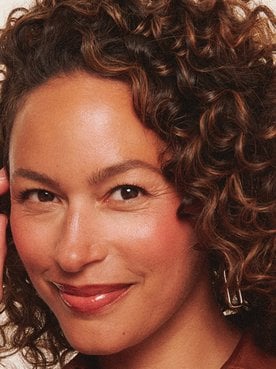Foundation and concealer are often seen as the main way to cover skin concerns like dark spots and under-eye circles, but color correcting is actually the best way to even your skin before you reach for your foundation. Color correcting is all about targeting and neutralizing the color of blemishes and hyperpigmentation, which is a common concern for those with dark skin. According to the American Academy of Dermatology (AAD), dark spots and patches are the result of when something like a pimple or wound triggers your skin to make more melanin than is needed.
Foundation can cover these spots, but if you’re dealing with a large amount of hyperpigmentation, you may need something extra. The good news is that color correcting is an easy way to do so, but you’ll need the right steps to effectively conceal these areas. Read on for six tips for color correcting on dark skin.
Featured Products
What Is Color Corrector?
Color corrector is a tinted makeup product that is used to even and balance out skin discolorations like dark circles, redness, and hyperpigmentation. Color correctors generally come in liquid or cream form, and the hues are based on the color wheel, where shades opposite each other on the wheel conceal each other out. That’s why green color correctors conceal redness, and orange correctors hide dark circles that appear blue.
Do You Put Color Corrector On Before or After Foundation?
Color correcting should come before foundation, as it’s meant to provide a base for your foundation, concealer and other beauty products to come. Your foundation will cover both the shade of the color corrector and the imperfection that you’re trying to correct.
1. Color Correct After Primer
Color correcting is meant to be done right after primer and before applying foundation. If you color correct after your foundation and concealer, the shade of your corrector will sit on top of your makeup, and you won’t reap any of the product’s benefits since it won’t actually be correcting anything.
The only exception is if you’re using a primer that has a color corrector in the formula, such as the L’Oréal Paris Prime Lab Up to 24H Dullness Reducer, in which case your primer and color corrector will be the same step.
2. Choose the Right Shade of Color Corrector
The best color-correcting base starts with picking the right shade to address your problem areas. On dark skin, under-eye circles and hyperpigmentation tend to show up with a purple or blue hue, so a color corrector that’s red or orange, like the L’Oréal Paris True Match Color Correcting Crayon will cancel out the color that you’re trying to conceal.
And if you’re wondering if green color correctors work on dark skin, the answer is yes. A green color corrector will cancel out any redness on the skin as a result of acne or other forms of irritation — just be sure to pick a deep green shade instead of a paler green so you get the coverage you need.
3. Apply Your Color Corrector to the Right Spots
While color correcting is a great way to provide an even base for the rest of your makeup routine, color correcting on a spot where you don’t actually have anything to correct won’t do much for your makeup. It could even cause even more discoloration that’ll peek through your foundation. You want the color of your spot to be canceled out by the color corrector, so be sure that you’re only applying your corrector on areas like pimple marks, acne scars, hyperpigmentation, and under the eyes.
4. Use a Light Layer of Product
Applying a heavy layer of color corrector may seem like a good idea, but using a light, even layer is actually going to give you the best results. You’re still going to follow the corrector with foundation and concealer — which will add more coverage — and if you apply too much corrector you run the risk of the following face products not being able to adequately cover it.
5. Gently Blend the Corrector
When it comes to blending a color corrector, you want to strike the right balance so that the product’s color doesn’t totally disappear into your skin. Using a makeup sponge or your fingers, tap the color corrector into the skin, keeping the color centered on the spot that you’re trying to correct.
6. Don’t Add Extra Foundation
As we mentioned before, after you apply color corrector you can reach for your foundation. Apply the L’Oréal Paris True Match Super-Blendable Foundation over your light layer of color corrector with a brush or makeup sponge.
You don’t have to do anything special here and you won’t have to apply extra foundation to cover the spots that have color corrector on them — you may even find yourself using less foundation since you now have a more uniform base to start with. After foundation, you can move on to concealer, eye makeup, and the rest of your beauty routine.
Next: 5 Ways to Reduce the Appearance of Under-Eye Bags With Makeup
Photographer: Chaunte Vaughn, Art Director: Hannah Packer, Creative Producer: Becca Solovay, Digital Tech: Erik Dalzen, Photo Assistant: Sam Kang, Makeup Artist: Jonet Williamson, Hair Stylist: Mirna Jose, Hair Assistant: Keila Rivera, Wardrobe Stylist: Alexis Badiyi, Wardrobe Assistant: Jazmine Alzado, Model: Omega







